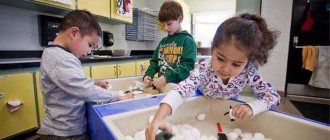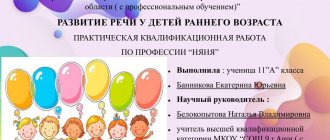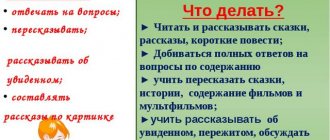Report to the teachers' council "Teacher's speech - an example to follow"
Averyanova Svetlana Aleksandrovna, teacher of speech therapy group, Saratov region, Saratov
Dear colleagues - good afternoon The topic of my speech is devoted to the teacher’s speech, since speech is the most important means of communication between people and serves as a role model for students.
Cultural speech is an essential element of a person’s general culture. It is no coincidence that it is believed that a person’s speech is his calling card, which testifies to his erudition, intelligence, ethics, and upbringing. The more expressive, precise and colorful the language, the clearer the thought is expressed, the more effectively it influences the child, his own speech, the greater the opportunity to reach the child’s mind and heart. And this is real art. Any teacher who strives for this can master correct and beautiful speech. Preschool children imitate those around them, adopting not only all the subtleties of correct pronunciation, word usage, phrase construction, but also those speech imperfections that are found in adults. The culture of children’s speech depends on the teacher’s speech culture. The speech of the teacher, who is constantly in the field of view of children, in communication with them, is the main source from which children receive a sample of their native language. An adult’s speech must be maintained at a certain pace, volume, must be intonationally expressive, grammatically formatted, coherent, understandable, with the correct and accurate use of verbal notations. A story read by a teacher using expressive means arouses interest in children, makes them empathize, and remember the content for a long time; the same story read dryly, at a fast pace, without emotion, can only cause boredom and indifference to a work of art. The teacher must be self-critical of his own speech and, if there are shortcomings in it, strive to eliminate them. To know about the perfection of his own speech, the teacher needs to listen to the comments of his comrades. Children will be more successful in learning the sounds of their native language from a teacher with intelligible, clear, distinct speech. The teacher’s speech should be emotionally rich, rich in intonations, quite loud and leisurely. Slow speech is easier for children to perceive, follow its content, and remember the text. Voice is the most important element of speech technique. For a teacher, it is the main tool of work. There are a number of requirements for the voice: • the voice should not cause unpleasant sensations. It is important that the teacher’s voice does not sound unnecessarily - this tires both the adult and the children. • the teacher must be able to change the characteristics of his voice, taking into account the communication situation, he must be able to control his voice; a characteristic mistake of many teachers is to try to shout over the general talk of children • the teacher must be able to control his voice in communication with other people, speak not for himself, but for the listeners • with With the help of his voice, the teacher must be able to instill in children certain requirements and achieve their fulfillment. • the teacher's voice must be strong enough. Diction is the clear and precise pronunciation of speech sounds. Good diction is ensured by strict adherence to the articulatory characteristics of sounds. Unclear articulation results in slurred speech and makes it difficult to understand the speaker. An important component of speech is orthoepy - the correct literary pronunciation of all words of the native language. The difficulty in mastering correct literary pronunciation lies in the fact that pronunciation does not always coincide with spelling. Therefore, generally accepted norms of literary pronunciation should be learned. If you have doubts about the correct pronunciation of words and emphasis, use dictionaries and reference books. Expressiveness is another element of a teacher’s professional speech. For oral speech, it is very important to correctly use intonation means of expressiveness of logical stress, isolating from a phrase the main words or phrases in meaning by raising or lowering the voice, changing the tempo, pauses, the melody of speech, the movement of the voice in speech in height and strength, the tempo of the number of words spoken in a certain unit of time. Intonation makes speech lively, emotionally rich, thoughts are expressed more fully and completely. In modern conditions, improving the speech culture of preschool teachers is considered as one of the conditions for improving the quality of preschool education. Therefore, the speech of teachers is subject to certain requirements: Requirements for the quality of speech of a teacher of a preschool educational institution Correctness - compliance of speech with language norms. When communicating with children, the teacher uses the basic norms of the Russian language, orthoepic norms, rules of literary pronunciation, as well as norms for the formation and change of words. Accuracy is the correspondence between the semantic content of speech and the information that underlies it. The teacher should pay special attention to the semantic semantic side of speech, because This helps children develop accurate word usage skills. Logicity is the expression in semantic connections of the components of speech and the relationships between the parts and components of thought. When communicating with children, the teacher takes into account that in preschool age ideas about the structural components of a coherent statement are formed and skills are formed in using various methods of intratextual communication. Purity is the absence in speech of elements alien to the literary language. Taking into account the leading mechanism of speech development of preschoolers is imitation, the teacher takes care of the purity of his own speech; the use of filler words, dialect and slang words is unacceptable. Expressiveness is a feature of speech that captures attention and creates an atmosphere of emotional empathy. The expressiveness of a teacher’s speech is a powerful tool for influencing a child. A teacher who is proficient in various means of speech expressiveness—intonation, rate of speech, strength, pitch of voice, etc.—contributes not only to the formation of the child’s spontaneous expressiveness of speech, but also to his more complete awareness of the content of an adult’s speech, and the formation of the ability to express his attitude to the subject of conversation. Richness is the ability to use all linguistic units in order to optimally express information. The teacher’s rich vocabulary helps expand the child’s vocabulary, helps develop his skills in accurate word usage, expressiveness and figurative speech, since in preschool age the foundations of the child’s vocabulary are formed. Relevance is the use in speech of units that correspond to the situation and conditions of communication. The appropriateness of the teacher’s speech presupposes, first of all, having a sense of style. Taking into account the specifics of preschool age, the teacher aims to develop in children a culture of speech behavior, communication skills, the ability to use various formulas of speech etiquette, focus on the communication situation, the interlocutor, etc. The above requirements include the correct use of non-verbal means of communication by the teacher, his ability not only to speak with the child and with adults, but also to hear it. The most common mistakes in a teacher’s speech 1. The use of parasitic words Parasitic words are linking words that are firmly entrenched in a person’s vocabulary, firmly embedded in his colloquial speech, and become a habit. They disrupt the rhythm of speech and interfere with its understanding. The person himself, who has parasitic words in his speech, does not notice them. And the listener gets tired and exhausted. Especially often, a person who has parasites in his active vocabulary begins to use them when he is worried or in a hurry to deliver his speech. In this case, the parasites talk about the psychological characteristics of a person - that he is nervous, restless, hasty. Frequently used words are parasites “As if”, “along the way”, “damn”, “like”, “this”, “this is the same”, “here”, “well”, “well”, “well finally”, “in short”, “that is” “practically” “in any way” “tough”, “in general” “kick-ass” “no question” “no problem.” The presence of swear words in the lexicon indicates a person’s low culture. There are also parasitic sounds. Many people have the habit of saying “uh-uh,” “ah-ah,” or “mm-mm” when looking for the right word. This habit is usually very annoying to listeners. Parasitic words starting with the letter “Y” can be included in a separate category. These are the well-known “yoklmn”, “eprst”, “fir-trees-sticks”, “yo-moyo”, “yokarny babay”, “yoshkin cat”, “yoper theater”. 2. Frequent use of words with diminutive suffixes Mashenka, wash your hands. Katya, take the cup off the table. Affectionate words are very necessary, but your speech should not consist mainly of them. 3. Inaccurate naming of objects that surround the child and which he uses. It is necessary not to say the faceless “pants”, but to specifically call them “trousers”, “shorts”, “jeans”. Instead of saying “don’t forget your hat,” name a specific headdress: beret, cap, Panama hat, hat, baseball cap, etc. Why is this necessary? Before the baby learns to compare household objects with each other. He needs to learn to separate the essential - the main features of the subject from the unimportant and generalize. For example, what is the difference between trousers and shorts What do they have in common - how are they similar What is different about them When you name objects correctly and accurately, your child begins to have questions for you - why is it called that? This is an excellent reason to talk with your child, try to discuss how they are similar and how different objects differ. And this will be a life activity that is useful for both the child’s intellect and speech, and which will not require any special books or pictures, or your time. 4. The use in speech of rude vernacular and slang words that are opposed to the literary language sleep, cool, otpad, car, grandma, joke, joke, as well as abbreviations TV, video, comp. 5. Non-literary pronunciation of the words want - want, send - let's go, lie down - lie down, go - go, seal - pay, lay - put In the literary language there is no verb “lie”, but there is “put”, there is a verb “put”, but there is no verb "to put". The verb “to lay down” is used only with a prefix, and the verb “put down” is used without a prefix. There are many ways to ensure that a teacher’s speech is expressive, bright, and has a captivating effect on children. This is the appropriate use of proverbs, sayings, examples from life and literature, various metaphors, comparisons, the use of communication effects and non-verbal language. Affection and joke Small, but distant. Small but bold, as clear as the sun and as a star. Redder than the red sun, clearer than the clear moon. A hat with ears, a young man with curls. She grew up like a poplar tree. Kubariki-kubarishki, small children. You are my darling. She walks like a peacock swimming. Tanya's braid brings beauty to the whole city. Children grow like raincoats. Hey, give me your voice through the dark forest. I didn’t see how I fell, I’ll look and I’m still lying there. Foot taps against foot, boot clicks against boot. Let's sit down next to each other and chat. Right leg, left leg - rise a little. I would have told another fairy tale, but I forgot it at home. Scooter sleds, sit down and roll. They run quickly, but often fall. He blinked at one, nodded at another, and the third guessed it himself. Teaching or instruction Stand boldly for a just cause. Things aren't so bad for my friend. What they don’t talk about, don’t ask about it. If you hurry, you will make people laugh. Hurry, don't rush, but hurry up. You'll hurt your leg soon if you go. Quickly, the pen is in a lump and in a heap. Know how to lose, know how to find. So go through so that there is no knock, no trace. Know how to say, know how to remain silent. Know how to joke, know how to stop. If you like it, take it, if you don’t like it, don’t stir it up. The day until the evening is boring if there is nothing to do. Don't sit idly by, you won't get bored. Take care of your nose in the extreme cold. The frost is not severe, but it does not require standing. Condemnation Much noise - little use. They make noise like sparrows in the rain. Dust in a column, smoke in a yoke - either from dancing, or from dragging. The whole house is upside down. There is always a round dance at our gates. Without mischief for an hour. Some are cheerful, and some are hanging their noses. Our Filat is never to blame. Every Fedorka has his own excuses. Each other against each other, and all against Petrushka. I'm talking about boots, and he's talking about pies. Even the chicken is brave on her little street. Our arrow has ripened everywhere. Proverbs and sayings related to food and sleep They sang and sang, but they wanted to eat. Eat whatever they put in there. There was not a drop of dew or a drop of powder in my mouth. Eat bread and salt, and listen to good people. Eat more, live longer. Eat more, you will be a hero. Without salt it is tasteless, and without bread it is insatiable. Buckwheat porridge is our mother, and rye bread is our dear father. Leftovers are sweet. A tasty morsel to keep. It's time to sleep if there is no one to wait for. Dear friend - pillow. He sleeps with one ear and hears with the other. They slept, slept, or got up cheerfully. Thus, when working with children, the teacher should pay attention to the following: correctly pronounce all the sounds of the native language, eliminate existing speech defects. Have clear, precise and distinct speech, i.e. good diction. Use literary pronunciation in your speech, i.e. adhere to spelling standards. Strive to correctly use intonation means of expression, taking into account the content of the statement. When communicating with children, use speech at a slightly slower pace and moderate voice volume. Tell and convey the content of texts in a coherent and accessible form, using words and grammatical structures accurately. Along with the requirements for a model teacher, it is necessary to say about the requirements of the teacher for children. 1. The teacher must not only give a speech sample to the children, but also check how the children have mastered it; for this, exercises and repetitions are used. 2. It is necessary to cultivate children’s interest in the ability to speak correctly using incentives, an example of well-speaking children. 3. It is necessary to systematically monitor children’s speech, listen to how children speak, and correct mistakes in a timely manner. Serious attention should be paid to children’s speech in everyday life, as well as in the process of continuous educational activities. In conclusion, it should be said that the teacher’s speech pattern when teaching children can only be used when the speech culture of the teacher himself is impeccable. Speech is beautiful when it is like a stream, Runs among the stones, pure, unhurried, And you are ready to listen to its flow and exclaim, “Oh, how beautiful you are. View the publication (certificate of publication is on sheet 2 in the file with the certificate) Your documents are ready. If you are unable to download them, open them, or you made a mistake, please write to us by email (be sure to include the publication number in the letter)
REPORT FOR THE TEACHING COUNCIL ON THE TOPIC: "CHILDREN'S PLAY IN THE EDUCATIONAL PROCESS OF PRECEPTION OWE"
These could be, for example, positions related to work activities (such as
in the game of shopping), the roles of soldiers and officers in combat, etc. These are the games
most significant for the development of a child aged 4-6 years. Many teenagers and
adults, by the way, are also partial to such games; there is even a whole
subculture of “role-players”.
—Games with rules
. They represent artificial situations, often not
having direct and obvious parallels with real life, in which people
act on the basis of pre-formulated rules. Most often this is accompanied
competition. This group includes, for example, sports games - football, hockey or
volleyball, as well as various kinds of children's hide and seek, tag, shootouts, etc. Similar
games begin to predominate at primary school age, but persist further,
Most adults are not indifferent to some of them.
In addition to the types of games described above, there are also various types
games:
creative - arise on the initiative of children (include plot-role-playing; theatrical-
new-director's, dramatization games; design); didactic - occur according to
initiative of adults with ready-made rules for solving a learning task, maybe role-playing. They are the main form of training for preschool children; folk - created by the people.
What are the functions?
does the game do?
The first function of the game is educational
- contributes to the development of the child as a person:
the ability to express oneself, realize one’s needs, be aware of one’s likes and dislikes, explore one’s feelings, and learn to control one’s behavior. Some games
develop strength, endurance, and others - intelligence.
The second function is compensatory
- is based on the fact that the game appears as a different reality; the child is attracted by the opportunity to reveal his abilities, which are difficult to develop in the adult world.
The third function is psychotherapeutic
(healing), in the game, situations that worry a child are “lived” with the full attention and empathy of an adult. While playing, the child splashes out negative emotions, thereby reducing their tension, and finds ways out of difficult situations.
Another function is diagnostic
. In the game you can see the child’s problems, see how he imagines his parents, teachers, and himself. In the game the child reveals himself, since it is symbolic, everything is “make-believe.”
While playing, the child gains certain knowledge, skills, develops memory, thinking, speech... In classes with preschoolers, teachers for better learning
educational material uses a large number of gaming techniques. Special educational games (“Odd Four”, “Puzzles”, “What First, What Then” and others) help the child learn about the world in a more accessible and exciting way.






